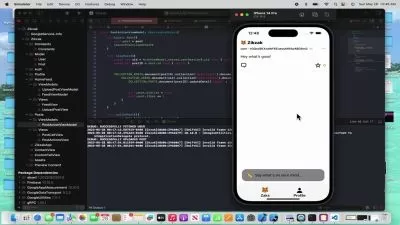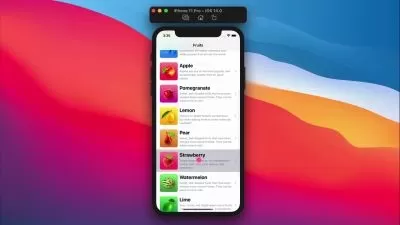Starting with SwiftUI: essentials of descriptive UI
Web Academy
1:10:08
Description
What is deciriptive UI and how SwiftUI different from UIKit
What You'll Learn?
- How to start new SwiftUI project
- SwiftUI view essentials
- Descriptive UI: SwiftUI vs UIKit
- Building skeleton for UI
Who is this for?
What You Need to Know?
More details
DescriptionSwiftUI is a modern UI framework introduced by Apple, designed to make building user interfaces for iOS, macOS, watchOS, and tvOS easier and more intuitive. We cover some essential concepts and techniques for creating descriptive UIs with SwiftUI:
Views and Modifiers: Everything in SwiftUI is a view. Views are the basic building blocks of your UI. You compose views to create more complex UIs. SwiftUI provides a wide range of built-in views like Text, Image, Button, etc. You can customize these views using modifiers, which are methods that alter the appearance or behavior of a view.
Declarative Syntax: SwiftUI uses a declarative syntax, meaning you describe what you want your UI to look like, and SwiftUI figures out how to render it. This is in contrast to the imperative approach where you would specify each step to create and update your UI.
State and Data Binding: SwiftUI relies heavily on the concept of state. State represents the data that drives your UI. You declare state properties using the @State property wrapper. When the value of a state property changes, SwiftUI automatically updates the affected views. You can bind views to state properties using the $ prefix.
Layout and Stacks: SwiftUI uses stacks to arrange views horizontally or vertically. There are three main types of stacks: HStack (horizontal), VStack (vertical), and ZStack (for overlaying views). You use these stacks to organize the layout of your UI.
Navigation: SwiftUI provides built-in navigation features for building navigation-based user interfaces. You can use NavigationView along with NavigationLink to create navigation hierarchies. NavigationView provides a navigation bar, while NavigationLink allows you to navigate between different views.
Lists and Grids: SwiftUI offers List and LazyVGrid/LazyHGrid views for displaying collections of data. Lists are commonly used for displaying vertical scrolling content, while LazyVGrid and LazyHGrid are used for grid layouts.
Modifiers: SwiftUI provides a rich set of modifiers to customize the appearance and behavior of views. Modifiers allow you to change properties like font, color, padding, alignment, etc. You can chain multiple modifiers together to create complex UI designs.
Conditional Views and Loops: You can conditionally show or hide views using if statements or ternary operators. For iterating over collections, you can use ForEach to generate views dynamically based on the elements of the collection.
Gesture Recognizers: SwiftUI supports various gesture recognizers like tap, drag, long press, etc., which you can attach to views to enable user interaction. Gestures are implemented using modifiers like onTapGesture, onLongPressGesture, etc.
Custom Views and Modifiers: SwiftUI allows you to create your own custom views and modifiers to encapsulate reusable UI components and behaviors. You can define custom views by creating structs that conform to the View protocol.
Who this course is for:
- This course is designed for those who already have basic knowledge and skills in Swift development and want to develop them professionally.
SwiftUI is a modern UI framework introduced by Apple, designed to make building user interfaces for iOS, macOS, watchOS, and tvOS easier and more intuitive. We cover some essential concepts and techniques for creating descriptive UIs with SwiftUI:
Views and Modifiers: Everything in SwiftUI is a view. Views are the basic building blocks of your UI. You compose views to create more complex UIs. SwiftUI provides a wide range of built-in views like Text, Image, Button, etc. You can customize these views using modifiers, which are methods that alter the appearance or behavior of a view.
Declarative Syntax: SwiftUI uses a declarative syntax, meaning you describe what you want your UI to look like, and SwiftUI figures out how to render it. This is in contrast to the imperative approach where you would specify each step to create and update your UI.
State and Data Binding: SwiftUI relies heavily on the concept of state. State represents the data that drives your UI. You declare state properties using the @State property wrapper. When the value of a state property changes, SwiftUI automatically updates the affected views. You can bind views to state properties using the $ prefix.
Layout and Stacks: SwiftUI uses stacks to arrange views horizontally or vertically. There are three main types of stacks: HStack (horizontal), VStack (vertical), and ZStack (for overlaying views). You use these stacks to organize the layout of your UI.
Navigation: SwiftUI provides built-in navigation features for building navigation-based user interfaces. You can use NavigationView along with NavigationLink to create navigation hierarchies. NavigationView provides a navigation bar, while NavigationLink allows you to navigate between different views.
Lists and Grids: SwiftUI offers List and LazyVGrid/LazyHGrid views for displaying collections of data. Lists are commonly used for displaying vertical scrolling content, while LazyVGrid and LazyHGrid are used for grid layouts.
Modifiers: SwiftUI provides a rich set of modifiers to customize the appearance and behavior of views. Modifiers allow you to change properties like font, color, padding, alignment, etc. You can chain multiple modifiers together to create complex UI designs.
Conditional Views and Loops: You can conditionally show or hide views using if statements or ternary operators. For iterating over collections, you can use ForEach to generate views dynamically based on the elements of the collection.
Gesture Recognizers: SwiftUI supports various gesture recognizers like tap, drag, long press, etc., which you can attach to views to enable user interaction. Gestures are implemented using modifiers like onTapGesture, onLongPressGesture, etc.
Custom Views and Modifiers: SwiftUI allows you to create your own custom views and modifiers to encapsulate reusable UI components and behaviors. You can define custom views by creating structs that conform to the View protocol.
Who this course is for:
- This course is designed for those who already have basic knowledge and skills in Swift development and want to develop them professionally.
User Reviews
Rating
Web Academy
Instructor's Courses
Udemy
View courses Udemy- language english
- Training sessions 5
- duration 1:10:08
- Release Date 2024/06/25








